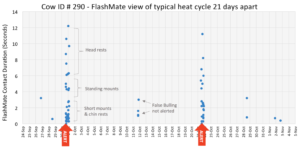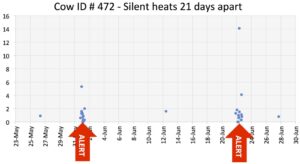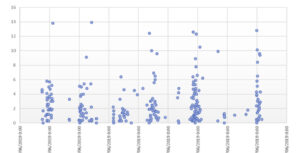How to use FlashMate?
Ask a neighbour or watch the short videos.
How to use FlashMate?
Ask a neighbour or watch the short videos.

FAQs
Patented touch sensing technology. Just like the screen on your phone. Inert objects likes trees, fences, rain and hail are ignored and won’t give false positives; only contact from living animals will be logged. The onboard microchip searches for patterns of contact that is highly diagnostic of heat. Unlike paint and patches, everything outside the pattern gets filtered out to eliminate these false positives.
FlashMate is the result of thousands of hours of clinical work over a period of eight years to achieve the most accurate mode of heat detection at a reasonable cost in terms of cost and time investment. No software training is needed.
The heat pattern is accurately alerted with a RED FLASHING LIGHT for 26 hours to indicate the optimal time for insemination. Then it will SWITCH OFF until further patterns of heat contact is detected. It’s your job to submit the cow for closer inspection and breeding while the red light is flashing. Do not delay this for any reason.
Unlike paint and patches, a single occasional animal contact that is outside a pattern will not trigger a FlashMate alert. This is important later in the artificial breeding period where there is risk of inseminating pregnant cows from false positive alerts. Unlike paint, patches and activity monitors, there is no interpretation or analysis of data needed. Unlike activity monitors significant upskilling, software training and support is not required. We keep it simple so you can jet get the job done and get on with other priorities.
Below is what the pattern looks like for the FlashMate when data was manually extracted. Longer duration contacts are higher up and it can be immediately seen how striking and clear the heat patterns are and how obvious it is that any contact outside of the pattern can be ignored as incidental or false bulling.

FlashMate relies upon contact between animals in the herd. It cannot work on tie stall operations where cows can’t associated with each other. If you only have a small handful of cows, it will be difficult to establish a sexually active group and FlashMate may not receive enough contact from other animals to alert. FlashMate is touch sensitive, it doesn’t measure less reliable secondary signs at all. It does not measure movement, temperature or vocalisations from the animal. It measures and analyses primary physical contact associated with the cows reproductive cycle.

Touch sensing means contact is required rather than pressure. This means FlashMate can alert heats from an increase in attention from other cows even in the absence of standing mounts. Patches, paint and activity monitors (which measure secondary signs of heat) can miss many of these quieter heats. Just because a cow is not standing to be ridden or displaying obvious signs of heat does not necessarily mean that she is not cycling. Cows are very good at knowing when herd mates are cycling and FlashMate uniquely intercepts and alerts on the attention from other cows. Identifying just one extra cow in heat per hundred should come close to paying for the investment in FlashMate across the entire herd.
Below is a silent heat as the FlashMate sees and alerts it. This data was extracted from the unit. Note that the overall activity is much less, but still a very clear pattern to work with. The touch sensor is sensitive enough to register contacts between cows and alert heat on the quiet cows, whereas other methods that rely on pressure from mounting or secondary signs will suffer an absence of activity because these cows are behaving differently.

We’ve invested in good science and are the first to clinically demonstrate a lift in pregnancy rates from heat detection alone. We’ve linked the alerts back to actual conceptions and pregnancies by the thousands. First time users of FlashMate can find them `confronting’. All of a sudden you will be seeing cows with a red flashing light where your experience is telling you the cow cannot be in heat. These silent heats should be assessed by the AB Technician. Studies have shown the conception rates on these cows to be consistent with the rest of the herd.
As a first time user, you may also believe that cows that are coming into heat are not being alerted by FlashMate. Record these cows and you will probably see these cows alerting some hours later. Inseminating cows during early pre-heat will be less likely to achieve conception and will also drive up the insemination costs and short return rates. Many FlashMate users that are also AB Technicians have commented that FlashMate has given them the confidence to inseminate later than they otherwise would, and have seen conception rate increase in farm records subsequently.
Note also that if you are seeing regular heat alerts on a somewhat shorter schedule than the expected 21 days then you may have a cystic cow or some other reproductive issue. Consider having a vet look at this animal as soon as possible. Below is how a cystic cow appears in data that has been extracted from a FlashMate.

We’ve been working closely with the worlds top bovine reproductive researchers since 2013, supporting many peer-reviewed publications. Talk to us if you are looking for clean, precise and accurate primary heat data from herds.
This is the closest we can get to actual ovulation from “outside the cow”. The science linking primary heat signs to ovulation is very robust and FlashMate measures this very precisely. For the right collaborations we can discuss provision of special research data-logging units. We have successfully collaborated in studies undertaken in the USA, Ireland, UK, Japan, Russia, Estonia, China, South Africa and New Zealand.
FlashMate will alert multiple heats throughout the artificial breeding period. On average, farmers use between two and three patches to get a cow in-calf. Ignoring labour implications, the returns on greater accuracy and ease of use, you’re into a similar retail outlay as patches over a short mating period.
If you artificially breed for longer periods of more than six weeks, then FlashMate easily becomes cheaper on a cost/day basis. Then consider the value of accuracy reflected in conception rates and the extra early milk that puts into the vat, plus catching a few silent cows that your team would have missed and you are well ahead. Just one extra cow in every hundred that you get in calf should go close to paying for FlashMate across the herd.
Because they’ll alert multiple heats throughout the artificial mating period. FlashMate sticks to cow hair and cows moult. While a visual check may seem adequate, this is not the case. As hairs detach, there will come a time when the FlashMate may still appear to be stuck down visually, yet very few hairs are actually holding it on. As the next cycle begins, bulling may dislodge the product.
First time users often experience a `honeymoon’ period during the first 10 days and assume that all the FlashMates are still well stuck down just prior to the first returns on the next cycle a week after. They make a false assumption that these units will stay firmly attached, without effort on their part to follow instructions and risk disappointment.
The reapplication is about battening down the hatches prior to the next wave of bulling and is not a difficult job, especially if contrasting this with the daily work of touching up paint, applying missing patches or looking at activity data to make submission decisions. When you consider the value of identifying extra cows in heat and the quality submissions from FlashMate – with what that delivers to conception and in-calf rates; then it makes sense to put your most diligent team members onto the reapplication task.
Because FlashMate sticks to hair. Don’t shave that off the cows please. Early in the product development, this did occur to the team and many early customers. It seemed a good plan – but it wasn’t. A lot fell off. Others have tried this around the world with similar results. Just don’t try this, as it won’t go well.
FlashMate is calibrated to adult cow behaviour. Young virgin heifers behave differently and are a lot more active with lower social boundaries. This will result in additional contact between animals and create false positive alerts on a standard FlashMate.
Put your most diligent team member on brushing out coats – you’ll thank yourself later. Read all the instructions, watch the short videos and apply FlashMates three days prior to your planned start of mating.
You will see the occasional cow where you disagree with FlashMate. Silent heats alerting will present with no paint-rub or patches may be untouched. Get the opinion of the AB Technician. These `extra’ cows typically have a conception rate on par with the rest of the herd.
There will also be times where the cow is early in the heat and you will be able to see this, but the FlashMate is not yet alerting. Record cow numbers and check again some hours later to assure yourself that FlashMate is alerting. FlashMate is designed to deliver optimal conception rates when inseminations are made during alerts. Earlier inseminations will have a lower conception rate and once alerting, you then need to consider inseminating again.
Ensure you have all team members record any instances where they ignored FlashMate and bred cows that were not alerting, or failed to breed a cow with a FlashMate alert. Keeping everyone `on script’ is important, so it is important to know why deviations were made so that dated pregnancy scans can be looked at later to determine the outcomes and financial costs of these decisions. Breeding cows that are already pregnant carries a known high risk of embryonic death. By the time cows mistakenly bred later in the artificial breeding period recover, normal cycling may not re-establish until after the bull has departed or AB has ceased.
In your first season using FlashMate, expect to use an additional 20% of extra units to replace any bulled off while your team gets used to the product and learns how to best maintain them on the cows as per instructions.
Unopened bags can be kept for later use. Partially used packs can also be used the following season so long as they are taped into the bags they came in and set aside, away from any contact.
You will need additional adhesive for further reapplication if you are artificially breeding longer and possibly eliminating bulls altogether. FlashMate is sold with enough adhesive for six weeks of use. For 10 weeks or more of mating, budget a further 30% replacement units and ensure you have these close on hand.
Because you may like to take a break from farm, sleep in more or simply share early starts around. It’s like having another set of highly skilled eyes on the cows. In many cases the heat detection can be done from cups-on or cups-off which can save labour. Financially, FlashMate gives you a return in several ways without multi-year lock in or having to undergo training.
Picking cows that your team would have missed has a large payback. Getting just one extra cow in-calf for every hundred cows will come close to paying for FlashMate across the herd, even on a low payout. This does not consider labour savings, using less straws or reductions in bull cover.
FlashMate is the most accurate heat detection approach available and you will see this reflected in your conception rates. Accuracy brings conceptions forward and therefore puts more milk in the vat earlier. You will see this in your three week in-calf and six week in-calf rates. FlashMate is the only heat detector to clinically demonstrate a 6.3% lift in six week in calf rate. In New Zealand that is worth your herd number multiplied by 6.3, then that number multiplied by $4 (based on a $5.50 payout).
Ultimately higher conception rates from better submissions and catching silents heats positively affects empty rates also. Similarly, getting cows in-calf as soon as possible allows tightening of calving spread which has positive impact on next years mating, reducing the impact of late-calvers. FlashMate really earns its keep with the 50/50 and quiet cows, reducing decision-making stress. Let’s face it, herds have grown larger over time and staff are only human, there’s never been more distractions and other priorities around farm.
FlashMate keeps it totally simple. When the red light comes on, submit the cow.
Best in class. Make sure your most diligent people brush the cows out with a quality rubber curry comb and apply FlashMate properly, especially given the value of accurate heat detection. As far as stick-on aides go, FlashMate enjoys superior retention, as they are positioned off the tail-head. This is possible because FlashMate does not rely on pressure or force; FlashMate requires contact only. Any product that adheres to the animals hair faces a challenge to maintain high retention through periods of heavy moulting. That is why following the instructions around application and reapplication is critical.
While first-time users should expect up to 20% to get bulled off, around the world it has become common to have 90%+ FlashMates retained across the artificial breeding period, but this is contingent on the quality of the effort made. During early clinical work, more than 92% of original devices were retained throughout the mating period across more than 3,000 cows in different locations. In very rare cases where more than 20% of units are bulled off and instructions have been diligently followed, there is a high likelihood of mineral deficiency, or some other health issue affecting the cow coat.
During normal use, FlashMates dislodged by very heavy bulling are not going to be missed heats in any case. FlashMate earns it’s keep on the quiet and “50/50” cows. If a thorough job of the reapplication is made, then you can be more confident submitting cows where FlashMate is missing. Spot-gluing or visual checking is unwise, because if any unit is missing, you cannot now be sure as to whether it was bulled off, or was simply not maintained properly.
Remember to remove all devices at the end of the artificial breeding period and dispose of them responsibly. Because FlashMate retention is superior, this means there can be less waste on farm than would be the case for patches (two to three times more used and more dislodging around the farm) or paint which represents many tiny plastic particles.
When FlashMate sees a heat pattern it flashes for 26 hours to indicate the window for optimal insemination timing. If you inseminate once daily, you may occasionally see a cow again 24 hours later. Weigh up the marginal cost of a straw versus the value of 3 weeks of milk or other costs of missing her. For most it’s an easy decision to breed again.
If you’re inseminating twice daily, then follow the AM/PM rule and use your judgement. Observe the cow and consider when the alert began – you may prefer to inseminate at the soonest opportunity or the next insemination. Consider farm policy as to whether you would inseminate again if FlashMate is still alerting later.
Directly, no. However, if you have not recorded a FlashMate alert for 25 days following an insemination then it is highly probably the cow is in-calf. FlashMate accuracy gives high-reliance that no heats have been missed; these will be true non-return cows with very high confidence. Animals that slip early on, then return to heat later, can also be alerted for management.
FlashMate is a herd-level product. Using 24 units in amongst 600 cows is likely to result in simply being `unsure’ which guarantees a poor outcome.
If you are not ready to use FlashMate across the entire operation, better to put FlashMate on every cow within smaller groups that are separately managed. Record extra cows alerted that a less experienced operator may have missed. Also record the cows that you believed were in heat and inseminated where there was no FlashMate alert. Once your dated pregnancy scans are in, be sure to go back over the data to look at conceptions.
On a 1,000 head farm, one farm manager attributed 27 additional extra heats to FlashMate with no paint-rub that they agreed would otherwise have been missed. Conception rate was 63% on those alerts. Conversely, where the farm manager submitted cows where FlashMate was not alerting, conception rate was just 4.3%.
The investment in full clinical studies at large scale has been made and FlashMate has been independently assessed by scientists around the world. However, if you If you wish to also assess FlashMate for yourself, please make solid and detailed records so that dated scans can establish the effectiveness of the heat detection decisions specifically, as distinct to any number of other management factors on farm in a given season. Alternatively get in touch with us directly for a more in-depth discussion.
Basically you need FlashMate on cows 1-3 days ahead of when you will be expecting heats to be expressed. They need to be stuck down well ahead of any wave of bulling.
If the FlashMates are already on the herd, consider reapplication of FlashMates, especially for the cows that you are synchronising to `batten down the hatches’ ahead of the expected bulling.
FlashMates have a button cell battery and give you accuracy at a low price point. They can go the distance for even the longest breeding season with no trouble at all, but should not be reused in future seasons. It is not worth the risk of missing cycles and the economic impact from this. The coin cell battery cannot run forever. While research and development continues in the company, recovering units, replacing batteries and getting units weatherproof again is currently not feasible.
Unopened bags can be kept for later use. Partially used packs can also be used the following season, so long as they are taped into the bags they came in and set aside away from any contact.
Because retention is excellent and frequently 90% or more can be retained to the end of a six week artificial breeding period, most units can be taken off the cows and disposed of responsibly. Stick on plastic patches and paint on the other hand will typically end up on farm to a greater degree than altternative approaches. Paint forms a plastic as it dries and crumbles. When you’re done with artificial breeding please dispose of FlashMate responsibly.
In the final analysis, getting cows in-calf through greater accuracy yields increased control and better management choices. If given the choice, there may be a preference that cows are in-calf, can remain in the herd longer and are not wasted, especially when considering the work, inputs and expense going into each productive cow. Also consider that having greater affordable accuracy can drive greater uptake of other available tools such as sexed semen and higher merit straws. These in turn can drive greater efficiency and less waste into the future herd. In these ways, improved control over reproduction can therefore reduce waste and increase productive efficiency in the longer run.
Not really. FlashMate requires far lower skill and experience than paint or patches and does not require investment of time into software training or ongoing system updating/maintenance. Staff can continue to come and go or be rostered on generally without being constrained to having just one or two highly trained people that can interpret paint/patches or use software. For staff that means that early starts can be shared around more and staff can take time off more readily. Your team simply needs to watch the videos and follow the instructions on the carton.

“I was an AI technician for 17 years and use quite a bit of sexed semen. We’ve used FlashMates for five seasons. We rely on them. We haven’t put any bulls out at all.”
Wayne Taylor
Board Member and former President of Holstein Fresian NZ
“Our empty rates have dropped a lot… you’re not getting that embryonic loss. We’re picking up silent heats with hardly any marking on the tailpaint. It makes the FlashMates pretty cheap, more people should be using them. We’ve trialled neck collars and FlashMates are a lot more attainable.”
Robert Buchanan
Suffolk North Farm
“FlashMate appears to save a lot of money at no extra cost. Using FlashMate we picked up cows I would have missed and mating cows unnecessarily can be a huge cost. The biggest noticeable difference is the lack of short returns.”
Erik Lenssen
Canterbury
“It’s a lot easier for the staff to see a light flashing than look at tailpaint. It’s less stressful than having to get up every morning to have a look and they’re not that expensive. They’re certainly picking up the silent heats. Easy to apply, easy to operate; it didn’t take any longer than tailpaint!”
John Tanner
Leeston, Canterbury
“Very simple for inexperienced people to make good decisions, tail paint can be subjective. I’ve had some comfort handing over to four of the guys on the farm, for one person to consistently get up at 4:30am is a big ask. We only had 10 out of 800 cows that came off over four weeks, so that was an exceptional result.”
Angela and Steve Reed
Darfield, Canterbury
“You're just crazy if you don't use them.... so far it's the best thing that I've seen. Normally over mating I would not have a single day off. But with Flashmate, I was able to. What impressed me the most was when we checked over the pregnancy results. A lot of cows were in-calf to the first mating. They had been accurately identified first time, even the ones that did not rub with tail paint. It would have been the best 4-week-in-calf we have ever had.”
Hamish Maclean
Manuwaru, Waikato
“With autumn-calving, cows are harder to pick. Using FlashMate we picked up cows we wouldn’t have seen. My 4 year daughter could pick cows! I had none come off the cows in the first six weeks and felt very comfortable that the right cows were going up for AB. It also gives you the delayed flash for when they’re actually on heat, rather than putting them up too early. I definitely felt it was an added edge in heat detection.”
